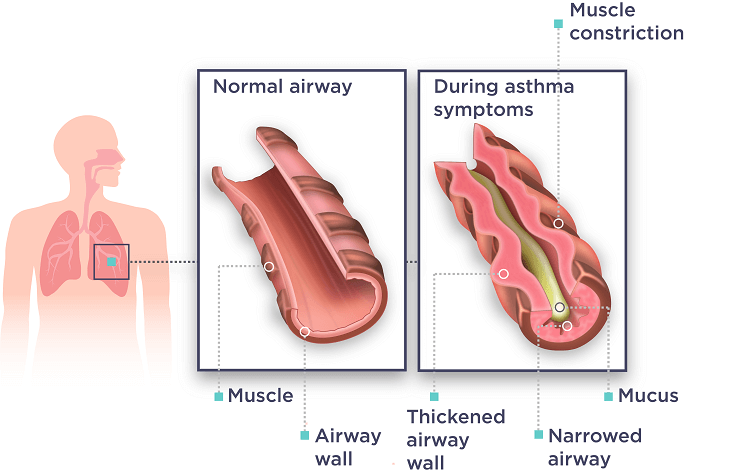Do I have asthma?
Asthma | 2/5/2020
In Europe alone, there are about 30 million children and adults who have asthma. In fact, asthma is such a common condition that we all are likely to know at least one person who has it.
Asthma can arise at any time and affect anyone at any age. While it’s not completely known why some people are more susceptible to asthma than others, there are several risk factors, such as allergies, overweight, smoking or being exposed to secondhand smoke. Also, having a parent or sibling with asthma could increase your risk for asthma.
Asthma is not just a bit of trouble breathing, it is a chronic inflammation (Fig. 1.) of the airways. This inflammation causes airways to be sensitive and makes them narrower. The narrowed airway then causes breathing difficulties. But how do you know if you also have asthma?

What are the symptoms of asthma?
The only way to be certain you have asthma is with a doctor’s diagnosis. Yet, there are a few symptoms to look for that might point to asthma. Shortness of breath, feeling tightness in your chest, or coughing and wheezing are some of the most common symptoms.
These symptoms vary from person to person and aren’t always persistent – they can come and go, appearing after a spurt of activity or sports, or worsening when you’ve got a flu or a cold. Coughing will likely be worse at night or early in the morning and the cough is dry. Difficulty breathing can also come on after being triggered by exposure to an allergen, like saliva or dander from an animal, pollen or dust or after your airway comes into contact with some other trigger, like tobacco smoke.
If you’ve been experiencing shortness of breath after exercise or are frequently having trouble breathing, it’s a good idea to see your doctor and get tested for asthma. After ruling out other conditions, your doctor will conduct a so-called asthma test. This means measuring your lung capacity using either a spirometry test or peak flow measurements that are specifically used for diagnosing asthma. Your doctor might also ask you to measure your peak flow at home to monitor how the medication is working.
Is it treatable?
The good news is that your asthma can be treated. After your initial diagnosis, your doctor determines the best treatment option for managing your asthma symptoms. Together you can create an action plan that might include combining the medication with lifestyle adjustments, such as quitting smoking or increasing activity and monitoring the wellbeing of your lungs.
It’s essential to start taking care of your lungs with a regular preventative medication, such as inhaled corticosteroids. You might also need to keep a reliever inhaler with you for situations when your asthma isn’t under control and you experience an asthma attack. You need to learn and maintain the proper technique for using your inhaler to ensure you’re getting the most out of your medication. This will make sure that the medication goes all the way to your lungs where it will suppress the inflammation and relieve the obstruction of the airways.
While having asthma may require some lifestyle adjustments, by keeping your symptoms under control with the right treatment, asthma won’t prevent you from living a normal life.
By Courtney Tenz
Photo by iStock
READ MORE:
5 tips to boost your immune system for winter
Track your highs and lows: Get the most out of your peak flow diary
What you should know about inhaled corticosteroids
References:
European Lung White Book. European Respiratory Society. Adult Asthma. https://www.erswhitebook.org/chapters/adult-asthma/
Global Initiative for Asthma. (2019). Global Strategy for Asthma Management and Prevention. https://ginasthma.org/wp-content/uploads/2019/06/GINA-2019-main-report-June-2019-wms.pdf
Jackson, D.J. et al., (2011), Asthma exacerbations: Origin, effect, and prevention, Journal of Allergy and Clinical Immunology, Volume 128, Issue 6, 1165 – 1174, https://doi.org/10.1016/j.jaci.2011.10.024
Paaso, E.M., Jaakkola, M.S., Rantala, A.K. et al. Allergic diseases and asthma in the family predict the persistence and onset-age of asthma: a prospective cohort study. Respir Res 15, 152 (2014) doi:10.1186/s12931-014-0152-8 https://respiratory-research.biomedcentral.com/articles/10.1186/s12931-014-0152-8
Orion Corporation is a globally operating Finnish pharmaceutical company. We develop, manufacture and market human and veterinary pharmaceuticals and active pharmaceutical ingredients. The dry powder inhaler developed at Orion is in the core of our respiratory therapy area.



